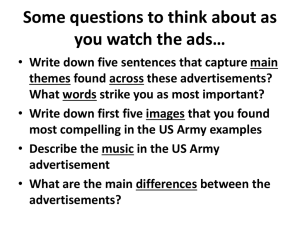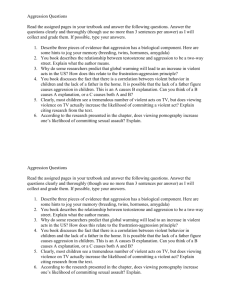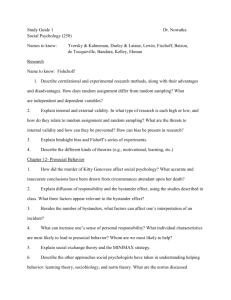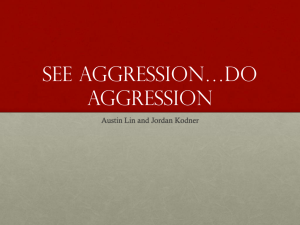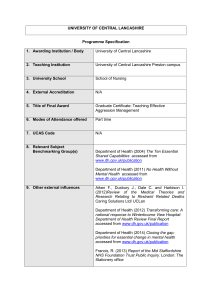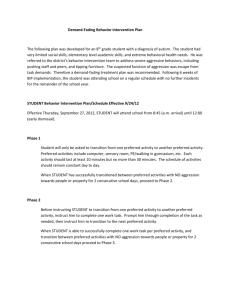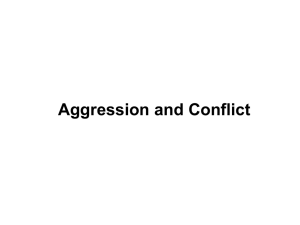Aggression and rejection
advertisement
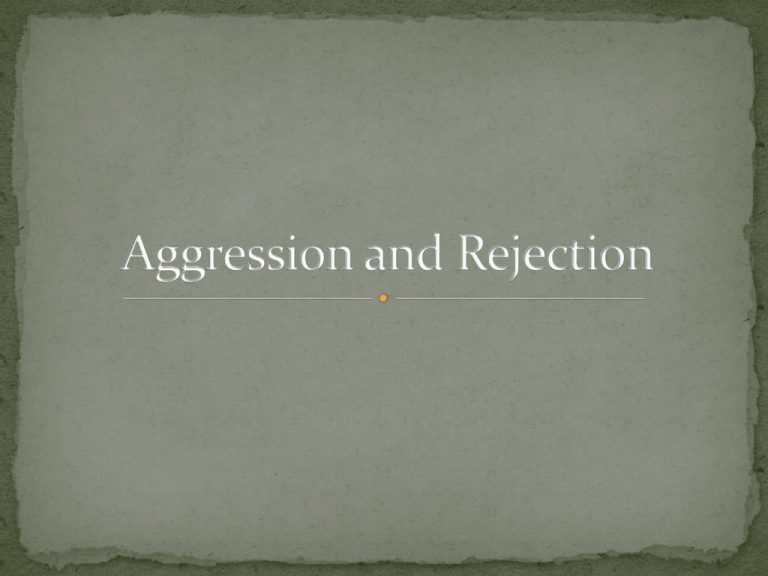
A cat kills a mouse. A man joins a rugby team. A farmer kills a turkey for dinner. A tennis player smashes her racquet after missing a serve. A soldier kills the enemy. A golfer breaks his club over his knee. A hunter kills an elk for his horns only. A woman sprays a would-be rapist with pepper spray. Two male college students fight over a female college student. A woman passes along a rumor about a friend’s affair. any form of behavior directed toward the goal of harming or injuring another living being who is motivated to avoid such treatment Hostile vs. instrumental aggression Direct vs. indirect (relational) aggression Aggression evolved so that men can establish dominance over other men and get higher status to protect their mates from other men Testosterone effects Chimpanzees vs. bonobos Culture Time Herding cultures Gender Frustration-aggression hypothesis Think of a time you felt frustrated Frustration leads to aggression if Have anger Important goal Blocked more times Blocked to a greater extent We learn aggression from watching others, especially if there are no negative consequences for it. Bobo doll study https://www.youtube.com/watch?v=eqNaLerMNOE Mirror neurons Social norms General aggression model Degree of hostility Automaticity Degree to which the goal is to harm victim vs. benefit perpetrator Degree to which consequences are considered How we interpret a situation affects how we respond to it Heat Noise Crowding Reminding someone of a violent cue Weapons Alcohol Marijuana Watching violent television increases aggressive behavior, angry emotions, and hostile thoughts May especially have effects on those already predisposed to violence May be especially problematic if the violence goes unpunished or is rewarded One-time surveys Experiments Longitudinal surveys Comparison of the Effect of Violent Media on Aggression With Effects From Other Domains Note. All correlations are significantly different from zero. a = the effect of smoking tobacco on lung cancer, as estimated by pooling the data from Figures 1 and 3 in Wynder and Graham's (1950) classic article. The remaining effects were estimated from meta-analyses: b = Paik and Comstock (1994), c = Weller (1993), d = Wells (1998), e = Needleman and Gatsonis (1990), f = Fiore, Smith, Jorenby, and Baker (1994), g = Welten, Kemper, Post, and van Staveren (1995), h = Cooper (1989), i = Smith, Handley, and Wood (1990), and j = Hill, White, Jolley, and Mapperson (1988). Bushman, B. J., & Anderson, C. A. (2001). Media violence and the American public: Scientific facts versus media misinformation. American Psychologist, 56(6-7), 477-489. doi:10.1037/0003-066X.56.6-7.477 © 2001 American Psychological Association People are also less likely to recall ads they saw during violent television shows Playing violent video games also seems to have an effect on aggressive behavior http://www.youtube.com/watch?v=X3SA0YdK53g Weakens inhibitions against violence (“they did it, so can I“) Shows people how to do violent acts May make people more likely to label feelings as anger Desensitizes us—makes us less affected by violence Makes people think the world is a more dangerous place Punishment Harsh punishment can actually teach aggression and doesn’t teach alternative responses Death penalty does not seem to deter crime Catharsis (acting aggressively) Count to 10 Defuse anger through apology Model nonaggressive behavior Training in problem solving Increase empathy Mental illness Guns Video games Teachers not being armed Bullied/ignored by other kids Divorced mother with guns Cyberbullying https://www.youtube.com/watch?v=HFsfDLCkfQU Ethnic aggression http://thinkprogress.org/justice/2012/08/21/716021/renewedstring-of-anti-islam-attacks-threaten-us-muslims-duringramadan/ Domestic violence Rape or date rape http://online.wsj.com/article/SB100014240529702042262045766 01174240952328.html School shooters Bullying (face-to-face) Think about the likely reasons why people do the type of aggression you were assigned Come up with an intervention to reduce that type of aggression Present it to the class Rejection affects the same part of the brain as when we feel pain Rejection hurts even if we can’t see the person rejecting us and even if it’s a person we don’t like https://www.youtube.com/watch?v=A3UTXsJzAj4 https://www.youtube.com/watch?v=X7EFYwUopf8 Smart-Richman & Leary model First feel bad and have lowered self-esteem Then react based on how you think about the situation: Perception of fairness Pervasiveness High value of relationship Expectations of relationship repair Possibility of alternative relationships High perceived cost of rejection Multimotive model of reactions to interpersonal rejection experiences. Smart Richman, L., & Leary, M. R. (2009). Reactions to discrimination, stigmatization, ostracism, and other forms of interpersonal rejection: A multimotive model. Psychological Review, 116(2), 365-383. doi:10.1037/a0015250 © 2009 American Psychological Association

